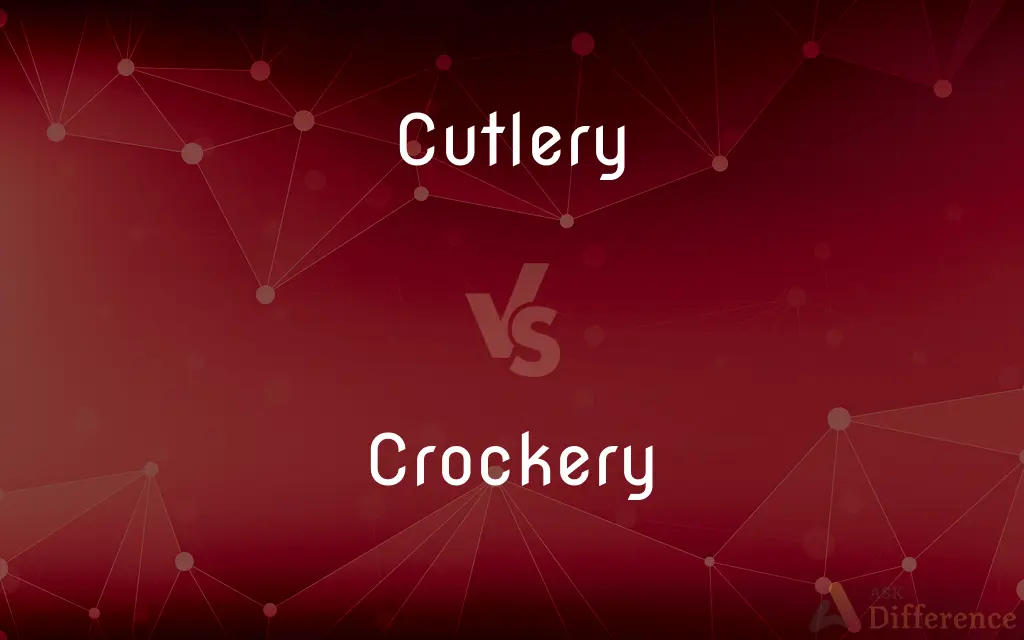Cutlery vs. Crockery — What's the Difference?
Edited by Tayyaba Rehman — By Urooj Arif — Updated on March 8, 2024
Cutlery refers to handheld instruments for preparing, serving, and eating food, whereas crockery encompasses various types of dishes or containers for serving and eating meals.

Difference Between Cutlery and Crockery
Table of Contents
ADVERTISEMENT
Key Differences
Cutlery typically includes knives, forks, and spoons, tools designed for cutting, spearing, and scooping food during the eating process. These utensils are usually made of metal, such as stainless steel or silver. Crockery, on the other hand, refers to the dishes or ware used for serving, eating, and drinking, such as plates, bowls, and cups. These items are often made from materials like porcelain, ceramic, or stoneware.
While cutlery is directly associated with the act of eating, aiding in the cutting and consumption of food, crockery serves as the base on which food is presented and served. This distinction highlights their complementary roles in dining.
Cutlery is essential for the practical aspects of dining, facilitating the physical consumption of food, whereas crockery enhances the dining experience by elegantly presenting the meal, impacting both the visual appeal and the practicality of serving sizes and temperatures.
In terms of maintenance, cutlery often requires regular polishing and proper cleaning to prevent tarnishing, especially if made of high-quality metals. Crockery, while also needing careful cleaning, may demand more attention to avoid chips or cracks, particularly with finer materials.
The cultural and historical significance of both can vary widely; cutlery's design and use have evolved based on dietary habits and culinary practices, while the shapes, sizes, and patterns of crockery often reflect cultural aesthetics and social customs, making both essential yet distinct elements of tableware.
ADVERTISEMENT
Comparison Chart
Material
Metals (stainless steel, silver)
Porcelain, ceramic, stoneware
Usage
Eating (cutting, spearing, scooping food)
Serving and eating meals (plates, bowls, cups)
Maintenance
Requires polishing and cleaning
Requires careful cleaning to avoid damage
Cultural Significance
Reflects dietary habits and culinary practices
Reflects cultural aesthetics and social customs
Example Items
Knives, forks, spoons
Plates, bowls, cups
Compare with Definitions
Cutlery
Blunt knives for spreading butter or soft spreads.
He spread the jam with a butter knife.
Crockery
Deep dishes for soups.cereals.or salads.
She filled the bowl with hot soup.
Cutlery
Instruments for cutting or spreading.
The chef used a sharp knife to slice the tomatoes.
Crockery
Flat dishes for serving individual portions.
The salad was served on a chilled plate.
Cutlery
Utensils with prongs for lifting or holding food.
She used a fork to twirl her spaghetti.
Crockery
Small plates for holding a cup.
She placed her cup on a matching saucer.
Cutlery
Tools for scooping or stirring liquids and soft foods.
He scooped the soup with a large spoon.
Crockery
Small vessels for drinking liquids.
He sipped coffee from his favorite cup.
Cutlery
Small spoons for stirring tea or coffee.
She added sugar to her tea with a teaspoon.
Crockery
Large dishes for communal food presentation.
The roasted chicken was placed on a serving dish.
Cutlery
Cutlery includes any hand implement used in preparing, serving, and especially eating food in Western culture. A person who makes or sells cutlery is called a cutler.
Crockery
Earthenware.
Cutlery
Knives, forks, and spoons used for eating or serving food.
Crockery
Crocks or earthenware vessels, especially domestic utensils, collectively.
Cutlery
Cutting instruments and tools.
Crockery
Dishes, plates, and similar tableware collectively, usually made of some ceramic material, used for serving food on and eating from.
Cutlery
Utensils such as knives, forks, and spoons used as tableware.
Crockery
Earthenware; vessels formed of baked clay, especially the coarser kinds.
Cutlery
The occupation of a cutler.
Crockery
Tableware (eating and serving dishes) collectively
Cutlery
A collective ensemble of eating and serving utensils such as knives, forks and spoons.
A cutlery set
This cutlery comes from Normandy, France
Cutlery
The business of a cutler.
Cutlery
The business of a cutler.
Cutlery
Edged or cutting instruments, collectively, especially knives for cutting food.
Cutlery
Eating utensils such as knives, forks, and spoons.
Cutlery
A cutting implement; a tool for cutting
Cutlery
Tableware implements for cutting and eating food
Common Curiosities
What is cutlery made of?
Cutlery is primarily made of metals like stainless steel or silver.
Is plastic cutlery considered real cutlery?
Plastic cutlery is a practical alternative for casual or outdoor dining but is not considered traditional cutlery.
How should I care for fine crockery?
Fine crockery should be hand-washed and handled with care to avoid chips and cracks.
Can crockery include glassware?
Crockery typically refers to ceramic or porcelain items, with glassware often considered a separate category.
How do I choose durable crockery?
Look for high-quality materials and manufacturing processes that ensure durability.
Are there specific types of cutlery for different cuisines?
Yes, different cuisines may use specialized cutlery, like chopsticks in Asian cultures.
Is it necessary to have matching cutlery and crockery sets?
While not necessary, matching sets can enhance the visual appeal of a dining table.
Can cutlery include serving utensils?
Yes, serving spoons and forks are considered part of cutlery.
What is the difference between a teaspoon and a dessert spoon?
A teaspoon is smaller, primarily for stirring drinks, while a dessert spoon is larger, for eating desserts.
How can I remove stains from crockery?
Gentle cleaners and soaking can remove most stains without damaging the crockery.
Are there etiquette rules for using cutlery?
Yes, many cultures have specific etiquette rules for using cutlery properly.
Can crockery be microwaved?
Some crockery is microwave-safe, but always check the manufacturer's guidelines.
Can decorative crockery be used daily?
While decorative crockery can be used daily, it may wear faster than more utilitarian designs.
How often should cutlery be replaced?
Cutlery can last many years with proper care, only needing replacement if damaged or for aesthetic reasons.
Are there environmentally friendly options for cutlery and crockery?
Yes, there are options made from sustainable materials and designed for long-term use.
Share Your Discovery

Previous Comparison
Photograph vs. Maps
Next Comparison
Strategize vs. StrategiseAuthor Spotlight
Written by
Urooj ArifUrooj is a skilled content writer at Ask Difference, known for her exceptional ability to simplify complex topics into engaging and informative content. With a passion for research and a flair for clear, concise writing, she consistently delivers articles that resonate with our diverse audience.
Edited by
Tayyaba RehmanTayyaba Rehman is a distinguished writer, currently serving as a primary contributor to askdifference.com. As a researcher in semantics and etymology, Tayyaba's passion for the complexity of languages and their distinctions has found a perfect home on the platform. Tayyaba delves into the intricacies of language, distinguishing between commonly confused words and phrases, thereby providing clarity for readers worldwide.














































